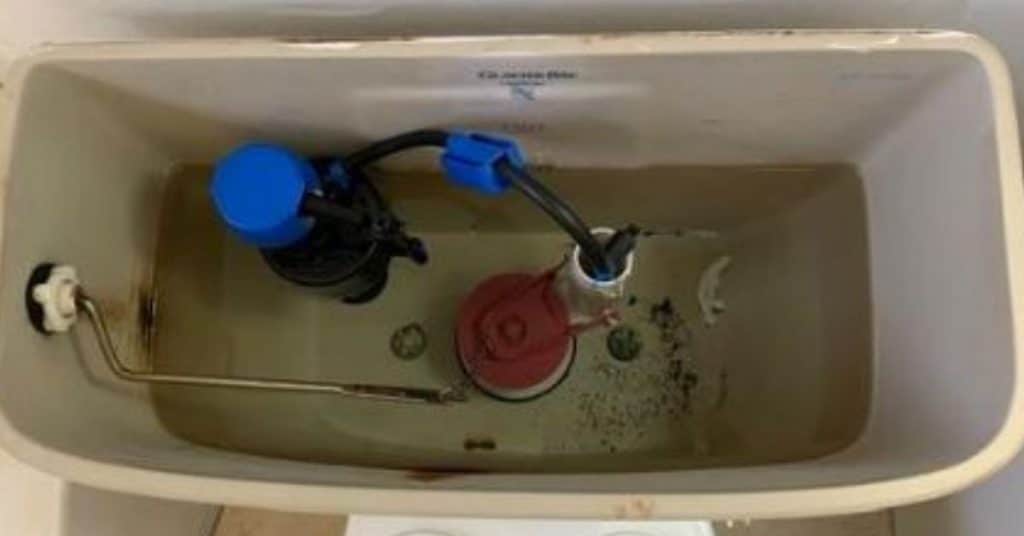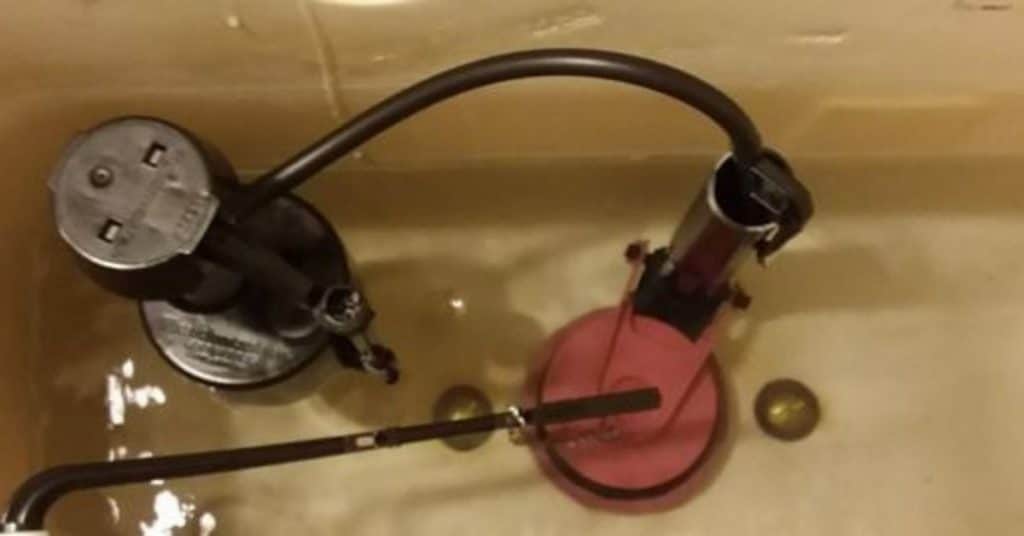Toilet Flapper Won’t Close? Do This
Last Updated on October 5, 2023 by toilethaven
Why Does a Toilet Flapper Stay Open?
A toilet flapper is connected to the flush handle using a lift chain and sits on top of the flush valve, opening when the toilet is flushed. It is designed to create a watertight seal to prevent water from entering the bowl from the tank unless the toilet is being flushed.

During flushing, you pull down the toilet handle, which creates tension in the chain, and as a result, it lifts off the flapper, allowing water to flow from the tank to the bowl via the flush valve.
After releasing the handle, the chain slacks, and the flapper falls down and seals the flush valve. In some cases, however, you will notice that the flapper will not close, resulting in a continuously running toilet.
This problem is especially common in areas with hard water. So, what causes a toilet flapper to fail to close?
A toilet flapper that won’t close is caused by debris and mineral buildup around its hinges, cone, and flush valve opening. It could also be caused by a very tight or slack lift chain, but sometimes, a worn-out flapper is the culprit.
The good thing here is that fixing this problem is a straightforward task, and you will hardly need to call a plumber to fix it for you. You will, however, need an emery cloth, a half-round file, or a new flapper, which are all cheap.
To fix a toilet flapper that won’t close, use an emery cloth or file to remove mineral build from the flush valve opening, flapper hinges, and seal, or use small weights to help it close. If the flapper chain is too tight or slack, adjust its length to just a ¼ inch slack. Replace the flapper with the flapper if it is worn out.
To weigh down a toilet flapper so it closes after flushing, add metal washers or small nuts on top of it one at a time until it starts to close normally. Since washers and nuts are prone to rusting, you will need to replace them every six months.
How Do You Fix a Toilet Flapper that Won’t Close?

As I have mentioned, fixing a toilet whose flapper won’t close is not that hard. Let us look at some ways you can fix a toilet whose flapper is stuck in the open position.
1. Check the Flapper Chain Length
Ideally, a toilet flapper chain is supposed to have an ¼ inch slack when the toilet is not being flushed. If the chain is too tight or too slack, there will be a problem.
Starting with a tight flapper chain, if it is too tight, it will unseat the flapper from the flush valve opening and prevent it from closing. As a result, you will end up with a running toilet and also deal with ghost flushing.
On the other hand, if the flapper chain is too slack, some might get caught between the flapper and the flush valve opening, again preventing the flapper from closing.
When the flapper chain length is too long/slack, you will also experience a weak flushing toilet since the flapper does not open all the way. A slack lift chain is also more likely to hook up on other toilet tank parts, meaning the flapper will not close.
Although this is rarely the problem, checking does not hurt. Adjust the flapper chain length only to have a slack of about ¼ to ½ inches.
Another thing that can make the flapper fail to close is when the chain is connected to the wrong hole on the flush handle arm.
A flush handle arm is a lever inside the tank connected to the flush handle with a series of holes along its length. Depending on the position of the flapper (or flush valve), you need to connect the flapper chain to the hole directly above it so that the flapper opens perpendicularly.
Don’t forget to adjust the flapper chain length after moving it to a different hole on the flush arm.
2. Remove the Mineral Buildup
If you live in an area with hard water, there will be a lot of sediment or mineral buildup at the bottom of the toilet tank.
The mineral buildup will also form at the top of the flush valve seal (where the toilet flapper sits), inside the flush valve opening, around the flapper hinges and around the cone of the flapper.
The buildup of minerals in any of these places will prevent the flapper from closing. This is why I would recommend cleaning the toilet tank frequently using vinegar to prevent this problem from happening in the first place.
One of the hardest places to clean is around the flapper hinges. As you already know, a toilet flapper is hinged on one side to help it open and close freely.
If the hinge has debris or mineral buildup around it, it will prevent the flapper (which is lightweight from closing). The only reason the flapper opens is due to the force applied to the flush handle during flushing.
Here is how you fix the problem:
- Turn off the water to the toilet. The toilet shut-off handle is on the wall behind the toilet.
- Flush the toilet
- Remove the toilet tank lid and place it away in a safe place where it cannot fall off and crack.
- Lift off the flapper from the flush valve opening and check if the mineral buildup is on the seal inside the flush valve, around the flush valve cone, and the flapper hinges.
- Use an emery cloth to scrub and remove all the buildup, which is usually calcium/limescale in most cases.
- If you do not have an emery cloth, use a half-round file, as shown in the video below.
3. Add Some Weights on the Flapper
To be honest, I didn’t know there was such a solution to this problem until I saw it on YouTube. You see, the reason the toilet flapper won’t close is because it is lightweight and therefore lacks enough force to bring it down to close.
By adding some weight on top of it, the flapper will close as soon as you let off the flushing handle.
I would, however, advise that you first clean the mineral buildup before trying this method. Toilet flappers are designed to close independently, and you don’t need to alter how they work by adding weights.
If you, however, want to try this method, this is how to go about it:
- Turn off the water to the toilet.
- Flush the toilet.
- Remove the lid.
- Disconnect the flapper chain from the flush handle arm.
- Start dropping metal washers on top of the toilet flapper until it starts to close promptly. This will be some trial and error. You can use tiny nuts or one big one if you don’t have washers.
- Connect the flapper chain to the flush handle arm and turn on the water.
- Flush the toilet a couple of times just to be sure that the problem is fixed.
- Put back the lid.
- Replace the washers/nuts after six months.
4. Replace the Toilet Flapper
If you have tried everything I have explained above without success, the only solution left will be to replace the toilet flapper. I would recommend going with the Korky adjustable toilet flapper.
Replacing a toilet flapper is easy. Just disconnect its ears from the flush valve pegs and also disconnect the lift chain from the flush handle arm, then lift it out.
Install the new flapper by placing it on top of the flush valve and hooking its ears to the flush valve pegs. Adjust the lift chain length and connect it to the flush handle arm.
And basically, that is how to fix a toilet flapper that won’t close. I hope this guide was helpful.